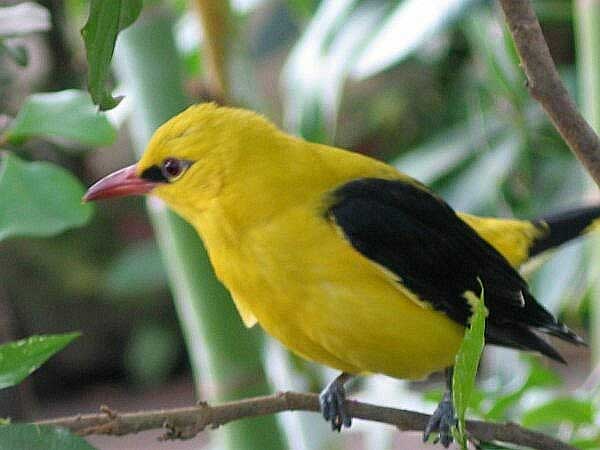Oriolus oriolus (*) Cladus: Eukaryota Name Oriolus oriolus (Linnaeus, 1758) Reference Systema Naturae ed.10 p.107 Vernacular Names
The Golden Oriole or European (or Eurasian) Golden Oriole (Oriolus oriolus) is the only member of the oriole family of passerine birds breeding in northern hemisphere temperate regions. It is a summer migrant in Europe and western Asia and spends the winter season in the tropics. Golden orioles have an extremely large range with large populations that are apparently stable. Therefore, they are evaluated as least concern by BirdLife International.[1] * 1 Description [edit] Description The male is striking in the typical oriole black and yellow plumage, but the female is a drabber green bird. Orioles are shy, and even the male is remarkably difficult to see in the dappled yellow and green leaves of the canopy. In flight they look somewhat like a thrush, strong and direct with some shallow dips over longer distances. The New World orioles are similar in appearance to the Oriolidae, but are icterids unrelated to the Old World birds. Distribution and habitat Golden orioles are native to Europe, Asia and Africa. Their range spans from Portugal, Spain and France across the United Kingdom and Scandinavia to Poland, Russia, the Balkans, Turkey and West Asia to the Caucasus up to Mongolia and China, as well as Pakistan, Himalayan range states,Western ghats of South India and Sri Lanka. They are vagrant in Sao Tomé and Principe, Congo, Gabon, Niger, Lesotho, Mali, Madagascar, Seychelles, Faroe Islands, Iceland and in Ireland.[1] They inhabit tall deciduous trees in woodland, orchards or parks and spend much of their time in tree canopies. Taxonomy and systematics Some recent works separate the Asian and European subspecies.[2] Ecology and behaviour They feed on insects and fruit. They build neat nests in tree forks and lay 3-6 eggs. Their call is a screech like a jay, but the song is a beautiful fluting weela-wee-ooo or or-iii-ole, unmistakable once heard. Listen to an oriole singing Etymolgy The name "oriole" was first used in the 18th century and is an adaptation of the scientific Latin genus name, which is derived from the Classical Latin "aureolus" meaning golden. Various forms of "oriole" have existed in Roman languages since the 12th and 13th centuries.[3] Albertus Magnus used the Latin form oriolus in about 1250 and erroneously stated that it was onomatopoeic because of the Golden Oriole's song. References 1. ^ a b c BirdLife International (2009). "Oriolus oriolus". IUCN Red List of Threatened Species. Version 2010.4. International Union for Conservation of Nature. http://www.iucnredlist.org/apps/redlist/details/146762. Source: Wikipedia, Wikispecies: All text is available under the terms of the GNU Free Documentation License |
|


